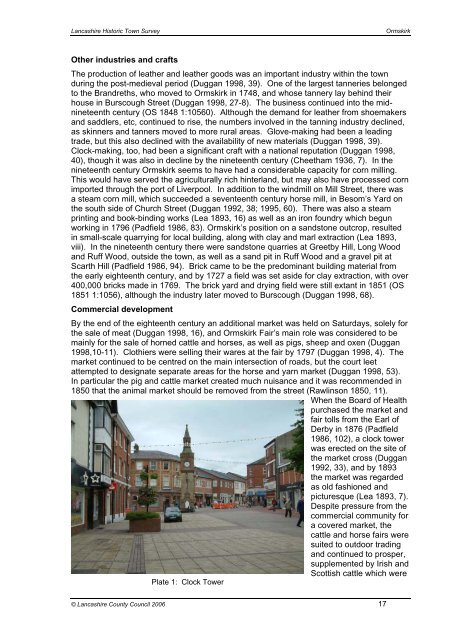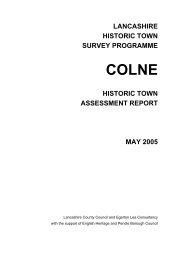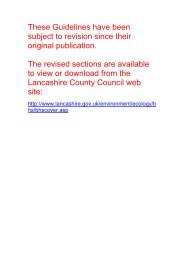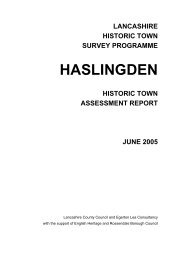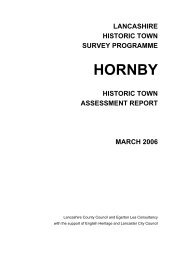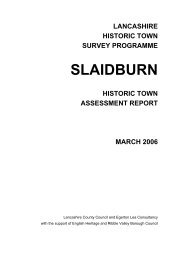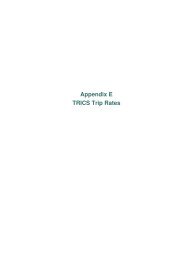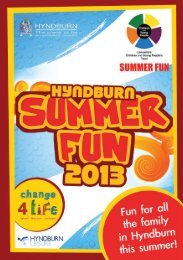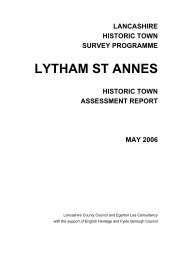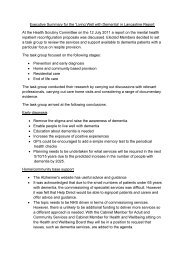ORMSKIRK - Lancashire County Council
ORMSKIRK - Lancashire County Council
ORMSKIRK - Lancashire County Council
Create successful ePaper yourself
Turn your PDF publications into a flip-book with our unique Google optimized e-Paper software.
<strong>Lancashire</strong> Historic Town Survey Ormskirk<br />
Other industries and crafts<br />
The production of leather and leather goods was an important industry within the town<br />
during the post-medieval period (Duggan 1998, 39). One of the largest tanneries belonged<br />
to the Brandreths, who moved to Ormskirk in 1748, and whose tannery lay behind their<br />
house in Burscough Street (Duggan 1998, 27-8). The business continued into the midnineteenth<br />
century (OS 1848 1:10560). Although the demand for leather from shoemakers<br />
and saddlers, etc, continued to rise, the numbers involved in the tanning industry declined,<br />
as skinners and tanners moved to more rural areas. Glove-making had been a leading<br />
trade, but this also declined with the availability of new materials (Duggan 1998, 39).<br />
Clock-making, too, had been a significant craft with a national reputation (Duggan 1998,<br />
40), though it was also in decline by the nineteenth century (Cheetham 1936, 7). In the<br />
nineteenth century Ormskirk seems to have had a considerable capacity for corn milling.<br />
This would have served the agriculturally rich hinterland, but may also have processed corn<br />
imported through the port of Liverpool. In addition to the windmill on Mill Street, there was<br />
a steam corn mill, which succeeded a seventeenth century horse mill, in Besom’s Yard on<br />
the south side of Church Street (Duggan 1992, 38; 1995, 60). There was also a steam<br />
printing and book-binding works (Lea 1893, 16) as well as an iron foundry which begun<br />
working in 1796 (Padfield 1986, 83). Ormskirk’s position on a sandstone outcrop, resulted<br />
in small-scale quarrying for local building, along with clay and marl extraction (Lea 1893,<br />
viii). In the nineteenth century there were sandstone quarries at Greetby Hill, Long Wood<br />
and Ruff Wood, outside the town, as well as a sand pit in Ruff Wood and a gravel pit at<br />
Scarth Hill (Padfield 1986, 94). Brick came to be the predominant building material from<br />
the early eighteenth century, and by 1727 a field was set aside for clay extraction, with over<br />
400,000 bricks made in 1769. The brick yard and drying field were still extant in 1851 (OS<br />
1851 1:1056), although the industry later moved to Burscough (Duggan 1998, 68).<br />
Commercial development<br />
By the end of the eighteenth century an additional market was held on Saturdays, solely for<br />
the sale of meat (Duggan 1998, 16), and Ormskirk Fair’s main role was considered to be<br />
mainly for the sale of horned cattle and horses, as well as pigs, sheep and oxen (Duggan<br />
1998,10-11). Clothiers were selling their wares at the fair by 1797 (Duggan 1998, 4). The<br />
market continued to be centred on the main intersection of roads, but the court leet<br />
attempted to designate separate areas for the horse and yarn market (Duggan 1998, 53).<br />
In particular the pig and cattle market created much nuisance and it was recommended in<br />
1850 that the animal market should be removed from the street (Rawlinson 1850, 11).<br />
When the Board of Health<br />
purchased the market and<br />
fair tolls from the Earl of<br />
Derby in 1876 (Padfield<br />
1986, 102), a clock tower<br />
was erected on the site of<br />
the market cross (Duggan<br />
1992, 33), and by 1893<br />
the market was regarded<br />
as old fashioned and<br />
picturesque (Lea 1893, 7).<br />
Despite pressure from the<br />
commercial community for<br />
a covered market, the<br />
cattle and horse fairs were<br />
suited to outdoor trading<br />
and continued to prosper,<br />
supplemented by Irish and<br />
Scottish cattle which were<br />
Plate 1: Clock Tower<br />
© <strong>Lancashire</strong> <strong>County</strong> <strong>Council</strong> 2006 17


